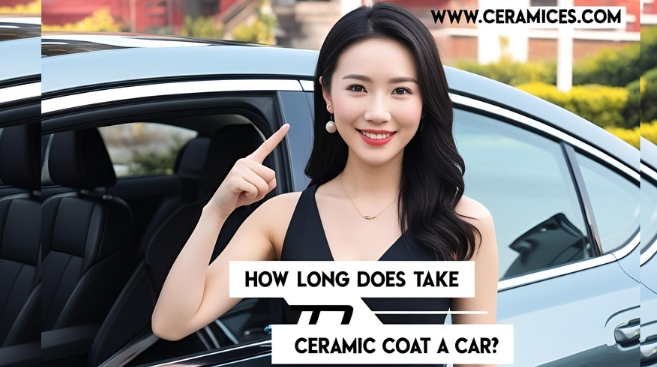Ceramic coating has become a popular choice for car enthusiasts and everyday drivers looking to protect their vehicle’s paint and enhance its appearance. Known for its durability, water-repellent properties, and glossy finish, ceramic coating offers long-lasting protection against environmental contaminants. However, one of the most common questions is, “How long does it take to ceramic coat a car?” This question is crucial for anyone considering ceramic coating, as it helps set expectations and plan accordingly. In this comprehensive guide, we will explore the time it takes to ceramic coat a car, the steps involved, and tips for achieving the best results. By the end of this article, you’ll have a clear understanding of the ceramic coating process and how to ensure a professional-quality finish.
What is Ceramic Coating?
Ceramic coating is a liquid polymer that, when applied to a vehicle’s surface, chemically bonds to create a protective layer. Made from silicon dioxide (SiO2) or titanium dioxide (TiO2), ceramic coatings offer exceptional durability and resistance to environmental contaminants. They are known for their hydrophobic properties, UV protection, and ability to enhance the vehicle’s gloss.
Benefits of Ceramic Coating
- Long-Lasting Protection: Ceramic coatings can last for years, depending on the quality of the product and maintenance.
- Water Repellency: The hydrophobic properties cause water to bead up and roll off, reducing water spots and making cleaning easier.
- UV Protection: Ceramic coatings protect against UV rays, preventing oxidation and fading.
- Enhanced Gloss: The coating adds a deep, glossy finish that enhances the vehicle’s appearance.
- Chemical Resistance: Ceramic coatings resist damage from chemicals, bird droppings, and tree sap.
How Long Does It Take to Ceramic Coat a Car?

The time it takes to ceramic coat a car depends on several factors, including the size of the vehicle, the condition of the paint, and whether you’re doing it yourself or hiring a professional. Here’s a breakdown of the time involved:
1. Professional Application
- Timeframe: 1 to 2 days
- Details: Professional detailers typically take 1 to 2 days to complete the ceramic coating process. This includes thorough cleaning, paint correction, and the application of the ceramic coating.
2. DIY Application
- Timeframe: 6 to 12 hours
- Details: If you’re applying ceramic coating yourself, it can take anywhere from 6 to 12 hours, depending on your experience and the condition of your vehicle.
3. Curing Time
- Timeframe: 24 to 48 hours
- Details: After application, the ceramic coating needs time to cure. This typically takes 24 to 48 hours, during which the vehicle should not be exposed to water or contaminants.
Steps Involved in Ceramic Coating a Car
The ceramic coating process involves several steps, each crucial for achieving a professional-quality finish. Here’s a detailed guide:
1. Gather Your Materials
Before starting, ensure you have the following:
- Ceramic coating kit (includes the coating solution, applicator pads, and microfiber towels)
- Car wash soap
- Clay bar or synthetic decontamination towel
- Isopropyl alcohol or surface prep solution
- Microfiber wash mitts and drying towels
- Foam applicator pads
- Gloves and masking tape (optional)
2. Wash the Vehicle Thoroughly
Start by washing the vehicle to remove dirt, grime, and contaminants. Use a high-quality car wash soap and a microfiber wash mitt. Rinse thoroughly and dry with a clean microfiber towel.
3. Decontaminate the Surface
After washing, use a clay bar or synthetic decontamination towel to remove embedded contaminants like tar, tree sap, and industrial fallout. This step ensures a smooth surface for the coating to bond properly.
4. Perform Paint Correction (Optional but Recommended)
- Polishing: Use a dual-action polisher to remove swirl marks, scratches, and oxidation. This step enhances the paint’s appearance and ensures a smooth surface for the ceramic coating.
- Inspection: Inspect the paint under a bright light to ensure all imperfections are addressed.
5. Perform Surface Preparation
Wipe the surface with isopropyl alcohol or a surface prep solution to remove any remaining oils, waxes, or residues. This step is crucial for ensuring proper adhesion of the ceramic coating.
6. Apply the Ceramic Coating
- Shake the Solution: Shake the ceramic coating solution well before use.
- Apply the Coating: Apply a few drops of the solution to the foam applicator pad. Work in small sections (about 2×2 feet) and apply the coating in a crisscross pattern for even coverage.
- Allow to Cure: Let the coating cure for the recommended time (usually 1-2 minutes).
7. Buff the Surface
After the coating has cured, use a clean microfiber towel to buff the surface gently. This removes any excess product and ensures a smooth, glossy finish.
8. Repeat the Process
Continue applying the coating section by section until the entire vehicle is covered. Be sure to follow the manufacturer’s instructions for curing times and layering.
9. Allow the Coating to Cure
Once the application is complete, let the coating cure for at least 24 hours. Avoid exposing the vehicle to water or contaminants during this time.
Tips for a Successful DIY Ceramic Coating

- Work in a Controlled Environment: Apply the coating in a garage or shaded area to avoid direct sunlight, which can cause premature curing.
- Use High-Quality Products: Invest in a reputable ceramic coating kit to ensure the best results.
- Take Your Time: Rushing the process can lead to uneven application or streaks.
- Wear Gloves: Ceramic coatings can be difficult to remove from your skin, so wear gloves to protect your hands.
- Follow Instructions: Always adhere to the manufacturer’s guidelines for application and curing times.
Pros and Cons of DIY vs. Professional Ceramic Coating
DIY Ceramic Coating
Pros:
- Cost Savings: DIY kits are more affordable than professional services.
- Convenience: You can work on your own schedule.
- Learning Experience: Applying the coating yourself helps you understand the process and care for your vehicle better.
Cons:
- Time-Consuming: The process requires significant time and effort.
- Skill Required: Achieving a professional finish can be challenging for beginners.
- Risk of Errors: Mistakes during application can lead to uneven coating or reduced durability.
Professional Ceramic Coating
Pros:
- Expertise: Professionals have the experience and tools to achieve optimal results.
- Time-Saving: The process is completed faster, often within 1-2 days.
- Warranty: Many professional services offer warranties for their work.
Cons:
- Higher Cost: Professional application is more expensive than DIY kits.
- Scheduling: You may need to book an appointment and leave your vehicle at the shop.
FAQs
1. How long does it take to ceramic coat a car at home?
DIY ceramic coating typically takes 6 to 12 hours, depending on the vehicle’s size and condition.
2. Can I drive my car immediately after ceramic coating?
No, you should wait at least 24 to 48 hours for the coating to cure before driving or exposing the vehicle to water.
3. How often should I reapply ceramic coating?
Ceramic coatings can last 1 to 5 years, depending on the product quality and maintenance. Reapply as needed based on the manufacturer’s recommendations.
4. Can I apply ceramic coating in direct sunlight?
No, direct sunlight can cause premature curing, leading to streaks or uneven application. Work in a shaded or indoor area.
5. Do I need to polish my car before ceramic coating?
Polishing is recommended to remove swirl marks and imperfections, ensuring a smooth surface for the coating to bond.
6. Can I apply ceramic coating over wax?
No, wax must be completely removed before applying ceramic coating. Use isopropyl alcohol or a surface prep solution to strip any wax residue.
7. How do I maintain a ceramic-coated car?
Wash the vehicle regularly with a pH-neutral car wash soap and avoid abrasive cleaners. Reapply a ceramic topper or maintenance spray as needed.
8. Can I apply ceramic coating myself?
Yes, DIY ceramic coating kits are available, but professional application ensures optimal results.
9. What happens if I apply too much ceramic coating?
Excess coating can lead to streaks, high spots, or an uneven finish. Buff the surface thoroughly to remove any excess product.
10. Is ceramic coating worth it?
Yes, ceramic coating is worth it for its long-lasting protection, ease of cleaning, and enhanced appearance.
Conclusion
The question “How long does it take to ceramic coat a car?” depends on whether you choose a DIY approach or professional application. DIY ceramic coating typically takes 6 to 12 hours, while professional services may take 1 to 2 days. Additionally, the coating requires 24 to 48 hours to cure.
By understanding the steps involved and following best practices, you can achieve a professional-quality finish that protects and enhances your vehicle’s appearance. Whether you choose to apply ceramic coating yourself or hire a professional, the long-lasting benefits make it a worthwhile investment.
So, if you’re ready to give your car the ultimate protection and shine, consider ceramic coating and enjoy the peace of mind that comes with a well-maintained, glossy finish. Happy driving!
Read more
1 How Much Does Ceramic Paint Coating Cost?